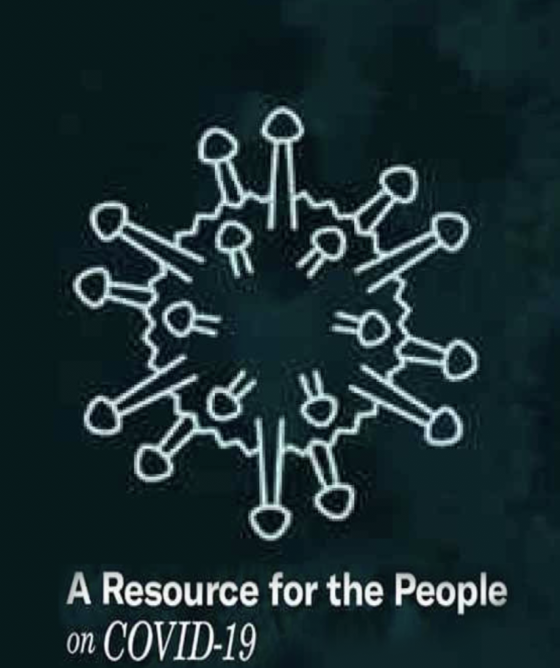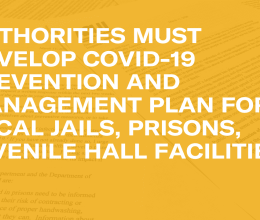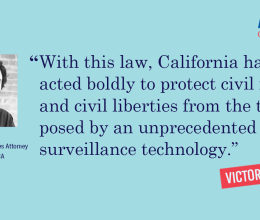The long-awaited independent, external audit of the San Diego County Sheriff’s Department’s use of force policies and practices was released today (June 25, 2007).
The following is the ACLU’s initial analysis of the 174 page audit and the Sheriff’s responses to the auditor’s recommendations.
Read the Audit and the Sheriff’s responses online. The audit was conducted by Los Angeles County’s Office of Independent Review (OIR).
Main Points
- This is a respectable, important first step for improving the Sheriff’s Department. The ACLU commends the Sheriff’s Department and OIR for its work on the audit. Overall, the audit and the Sheriff’s responses are very positive and reflect a commitment to modernizing the way the Sheriff looks at uses of force. If implemented, the recommendations may change the Department’s culture to one that asks, “How do we avoid harming civilians, suspects, and our own deputies whenever possible,” and not merely, “Did our deputies break the law?” Nonetheless, the ACLU has some significant concerns.
- There needs to be external monitoring of the implementation of the audit’s recommendations. The best solution is to invite OIR to return in six and twelve months to assess the implementation.
- The ACLU is pleased that the Sheriff’s Department has agreed to prioritize the design and implementation of an “Early Intervention System” (#30). E.I. Systems are an extremely important tool and a baseline best practice for modern law enforcement agencies. They are software programs that notify supervisors when deputies accumulate warning signs of a possible need for training, counseling, or other intervention. How the County’s system is designed and implemented will determine its usefulness and success—which is another reason the auditors should return to assess implementation. Click here for more about E.I. Systems.
- The ACLU is also pleased that the Sheriff’s Department has agreed (#34) to revise its poor, out-of-date handling of mentally ill people, which appears to be partly responsible for one of the controversial fatal shootings in Vista in the summer of 2005. However, the Department’s ambiguous response to this recommendation leaves some doubt that it will emulate best practices in the field and devote the resources necessary to address this problem meaningfully.
- Perhaps most significantly, the Department’s unfortunate rejection of the auditor’s recommendations (#14(a) and 17) to create a separate unit outside of the Homicide Bureau and regular detective staff means that there will continue to be serious risk of bias in the investigation of officer-involved shootings and other significant uses of force. The current system expects investigators to ignore that they are investigating their friends and colleagues whom they work with every other day in tackling civilian crimes. That expectation is unrealistic, and it is a system that creates a significant risk of cronyism in investigations. If the only investigation of a deputy’s use of force is infected by bias, every level of review above it will be too—including the reviews by the internal Critical Incident Review Team, the District Attorney, the State Attorney General, and the external, understaffed County Law Enforcement Review Board (CLERB).
- The Sheriff’s Department’s rejection of the recommendation to remove an intimidating, unnecessary warning from its citizen complaint forms (#35) is regrettable. The Audit failed to mention another important deficiency in the Department’s civilian complaint process—the broad discretion of the Internal Affairs Bureau to decline to investigate civilian complaints, even ones that appear valid and substantiated.
- Although the Audit mentions a newly positive working relationship between the Department and the County’s independent investigation and review agency the County Law Enforcement Review Board (CLERB), it does not address the need for CLERB to have more investigators.
- The Sheriff’s Department continued deliberation on several important recommendations, especially (#23) limiting the use of the carotid restraint technique, is yet another reason there needs to be follow up by OIR. Below, we list other Sheriff’s Department’s responses that require further clarification.
Further Clarification Required
According to the Sheriff’s Department’s response, the Department agrees with 25 of the 35 recommendations, agrees in part with seven, disagrees with two, and is undecided about one. But, the ACLU’s analysis found seven responses that were ambiguous and require further clarification. We elaborate our questions and concerns below and have communicated them to the Sheriff’s Department.
Sheriff Agrees: #s 2, 3, 4, 6, 7, 8, 11, 12, 14b, 14c, 14d, 19, 21, 22, 24, 25, 26, 28, 30, 31, 33
Sheriff Disagrees: #s 18, 35
Sheriff is Undecided: # 23
Needs Clarification: #s 1, 5, 9, 13, 14e, 20, 34
- 1: The Sheriff purported to agree in part with the recommendation to 1) give clarity to inconsistent statements in the Policy and Procedures sections of the Manual, AND 2) to adopt the more restrictive standard for use of deadly force. While the Sheriff’s Department addressed the first point by indicating that “the Department will implement a policy change to clarify the definition of a fleeing felony suspect,” the Sheriff’s Department did not address the second, more important point. It is unclear whether the Department will use the more restrictive standard for use of force against a fleeing felony suspect per the auditor’s recommendation.
- 5: While the Sheriff’s Department purports to completely agree with the auditor’s recommendation regarding “walk through” practices prior to personnel interviews, it is uncertain whether the two parties agree as to what “walk through” means. The recommendation is that such a practice need be “adopted,” but the Department claims that “this has been the practice in most investigations,” suggesting a difference of opinion on how often these interviews are conducted. The Department should clarify whether it agrees to satisfy the auditors’ intent. The codification of the procedure in the Homicide policy manual may provide this clarification.
- 9: The Sheriff’s Department purports to agree to formalize its protocols for informing witnesses of their rights and promoting witness cooperation. However, again, it is unclear whether the auditor and the department are seeing eye-to-eye. The Department states “Homicide has in place a form and waiver provision,” but the auditor’s recommendation suggests a procedure is not yet in place (“one option is to promulgate a form and waiver system”).
- 13: The Sheriff’s Department purports to agree with the recommendation to “explore ways to provide Risk Management personnel with a limited authority to respond to shooting scenes and immediately provides appropriate compensation to innocent parties who have suffered damages as a result of Department actions.” However, the Sheriff’s Department indicates that “further analysis” is necessary “to determine whether an ordinance would have to be adopted by the Board of Supervisors allowing the Sheriff’s Department to settle claims on behalf of the County.”
- 14e: The Sheriff’s Department purports to agree with requiring timely investigations and review presentations. However, the Sheriff’s Department indicates that the CIRB will “continue to be a two part review,” suggesting that the existing procedures will go unchanged.
- 20: The Sheriff’s Department purports to agree with the recommendation to encourage supervisors and handling deputies to speak with civilian witnesses. However, the Sheriff’s Department contends that this procedure is already in place because the use of force policy already requires the supervisor to investigate the use of force and the circumstances surrounding it. It is unclear, however, if this investigation of circumstances specifically includes interviewing civilian witnesses as the auditor recommends.
- 34: The Sheriff’s Department purports to agree with the recommendation to adapt its training of patrol deputies to be better equipped to deal with the mentally ill. The Sheriff’s Department indicates that this recommendation “requires further analysis” and “will implement the above recommendation as appropriate.” Thus it is not clear whether this recommendation will be implemented at all. Additionally, it is uncertain what the “analysis” consists of and whether the “revised policy and procedure” that is being formulated comports with the recommendation.









